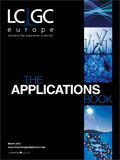Impurities in Wines by GC–MS
Thermo Scientific Application Note
Benedicte Gauriat-Desroy, Eric Phillips, Stacy Crain and Trisa Robarge (with special thanks to members of OEnologic Centre of Grezillac), Thermo Fisher Scientific, Austin, Texas, USA.
By identifying maturation tracers and molecules commonly responsible for taste defects, gas chromatography–mass spectrometry (GC–MS) augments expert opinion with objective and quantitative information. When using a solidphase micro extraction (SPME) method, GC–MS requires very small sample sizes and a minimum of sample preparation while providing rapid analysis of target molecules. GC–MS can provide an automated technique with repeatable results for detecting all of these compounds.
Extracted wine samples were analysed by a sequential full-scan/SIM acquisition on a GC–MS system consisting of a Thermo Scientific ISQ Single-Quadrupole GC–MS and a TRACE GC Ultra Gas Chromatograph. The results were compared to the sensitivity limits of human tasters. This method allows wine makers to obtain precise measurements on the organoleptic parameters that determine wine purity on site rather than having to send samples for expensive, external analysis.

Figure 1: 4-Ethylgaiacol from 50 to 100 µg/L: Y = 1.31e2X ^2 + 8.069e5X â 3.862e6; R^2: 0.9967; Origin: Ignore; W: 1/X; Area.
Method Conditions and Sample Preparation
The experimental conditions and sample preparation are described in Application Note 52242, Thermo Fisher Scientific, Inc.
Conclusion
GC–MS detects several contaminants in wine at lower concentrations than the limit of human tasters, and its ease of use with single-step, two-minute sample preparation make it a useful tool for the wine industry. The sequential full-scan/SIM acquisition method for detecting the impurities requires minimal training of personnel to provide accurate results. Also, this general method may be improved or customized to particular wines by incorporating new parameters.

Figure 2: Geosmine 112 from 10 to 50 ng/L: Y = -2.591e0X^2 + 2.543e4X + 2.694e5; R^2: 0.9995; Origin: Ignore; W: 1/X; Area.
The wine, champagne and spirit market can be well served by analytical chemistry tools such as GC–MS. By conducting their product analysis on site, wine and other spirit producers avoid their recipes being compromised when outsourcing this analysis. Also, analysing competitors' products using a GC–MS can help producers quantify what makes one wine superior to another.
Scan to receive complete application note.
Thermo Fisher Scientific Inc. (formerly Dionex Corp.)
2215 Grand Avenue Parkway, Austin, Texas, USA
tel: (800) 532-4572 fax: (561) 688-873 1
Website: www.thermoscientific.com

New Study Reviews Chromatography Methods for Flavonoid Analysis
April 21st 2025Flavonoids are widely used metabolites that carry out various functions in different industries, such as food and cosmetics. Detecting, separating, and quantifying them in fruit species can be a complicated process.
Analytical Challenges in Measuring Migration from Food Contact Materials
November 2nd 2015Food contact materials contain low molecular weight additives and processing aids which can migrate into foods leading to trace levels of contamination. Food safety is ensured through regulations, comprising compositional controls and migration limits, which present a significant analytical challenge to the food industry to ensure compliance and demonstrate due diligence. Of the various analytical approaches, LC-MS/MS has proved to be an essential tool in monitoring migration of target compounds into foods, and more sophisticated approaches such as LC-high resolution MS (Orbitrap) are being increasingly used for untargeted analysis to monitor non-intentionally added substances. This podcast will provide an overview to this area, illustrated with various applications showing current approaches being employed.

.png&w=3840&q=75)

.png&w=3840&q=75)



.png&w=3840&q=75)



.png&w=3840&q=75)
















